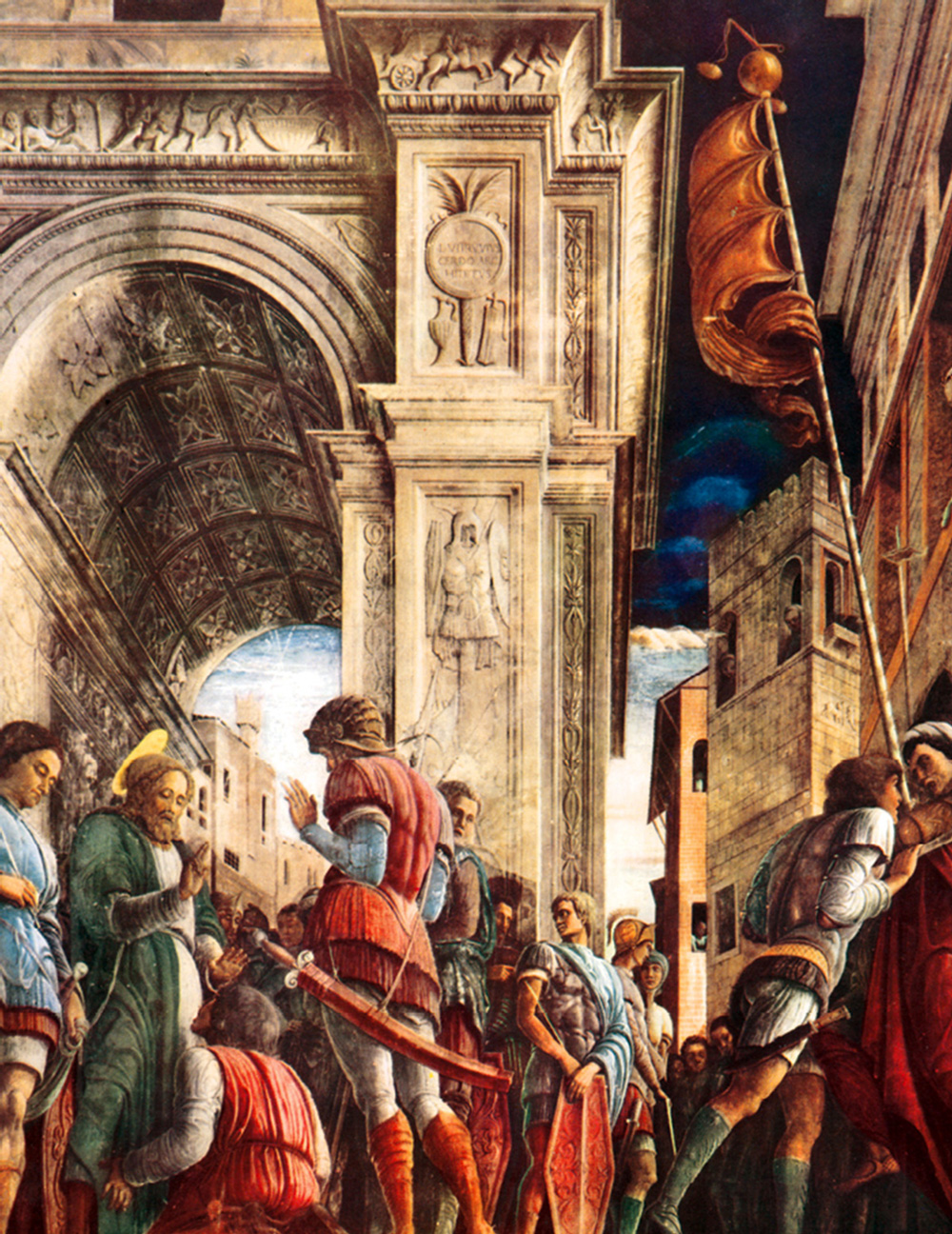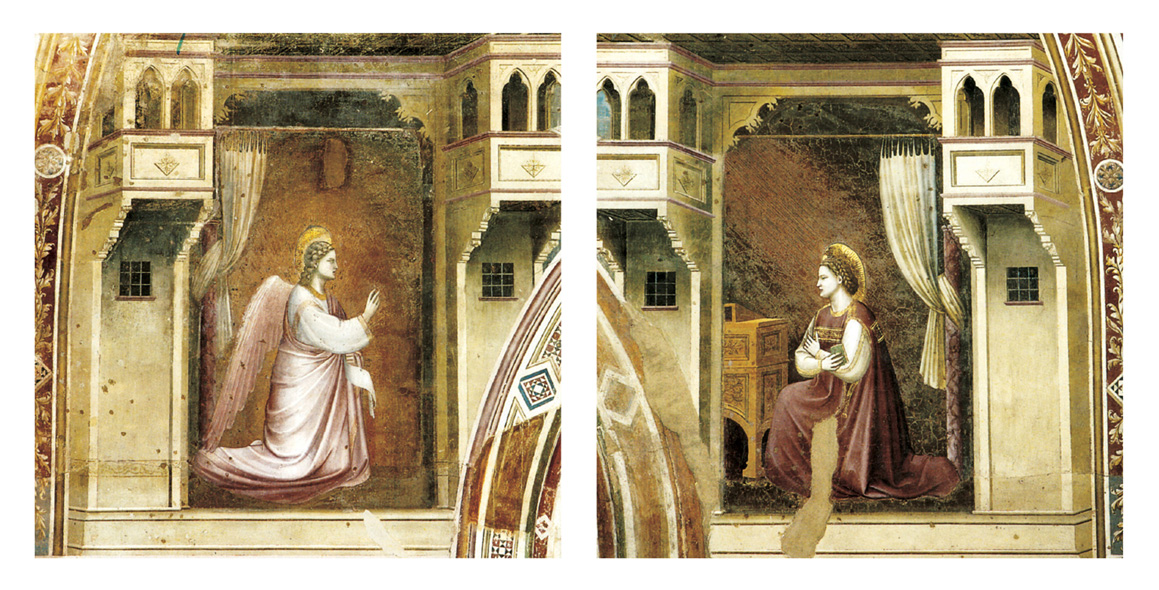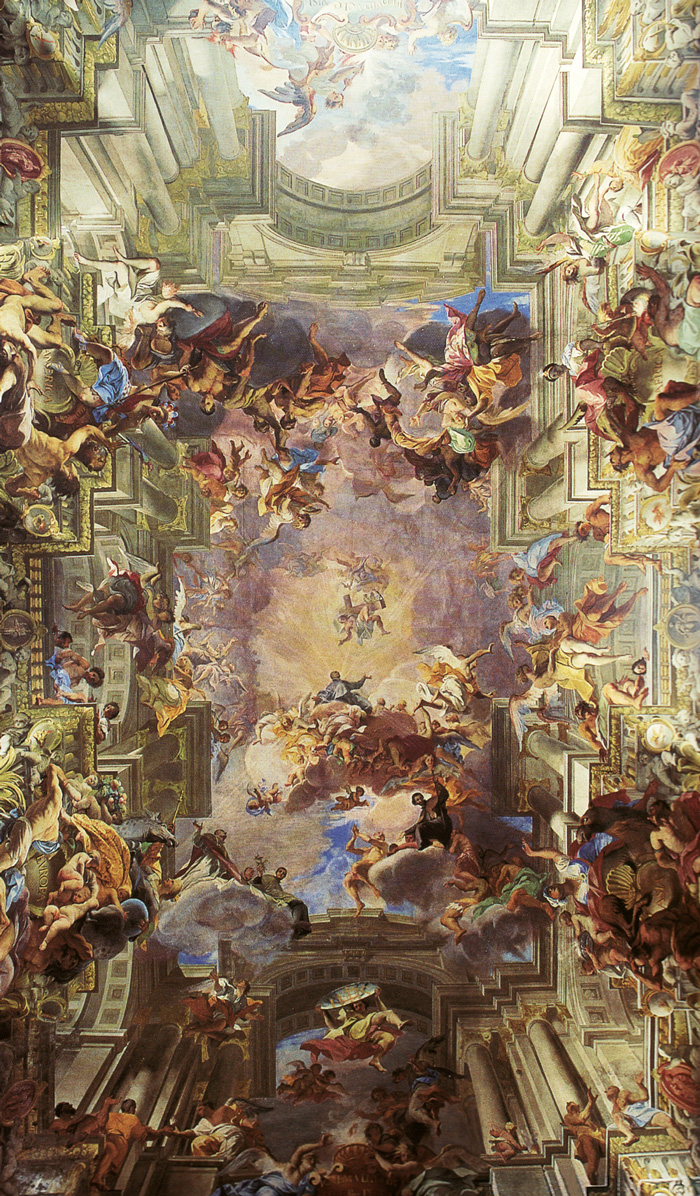The Illusionistic Magic of Geometric Figuring
Virtual reality, medieval-style
Margaret Wertheim
The failure of the Seventh Crusade in 1254 is not an event commonly noted in histories of the special effects industry, but the expensive blunderings of Louis IX in the deserts of the Levant precipitated a response that laid out the rationale for a program of visual illusionism not equaled until the advent of video games seven hundred years later. It came within the pages of a book, the Opus Majus, by the Franciscan friar Roger Bacon, or Doctor Mirabilis as he was known—one of the earliest champions of the medieval revival of mathematics and science, and a man who might justly be called the first virtual reality theorist.
If Jerusalem remained in the hands of the “infidel,” Bacon reasoned, it was not because the holy city was destined for Muslim dominion, but rather that Christian faith was lacking in vitality. A desire to revivify Christian passion drove Bacon to compile his scientific thoughts into the treatise that he sent to his friend Pope Clement IV in 1267, with the wish that it might help to inspire another crusade. Within the covers of this prescient work, which was at once a theological cri de coeur, a defense of natural philosophy, and a techno-utopian rant, Bacon heralded a coming age of flying machines and automotive carriages. He foresaw ever-burning lamps, explosive powders, and machines for lifting heavy weights. As a pioneer in the study of optics, he imagined glasses for concentrating sunlight to burn enemy camps and magnifying lenses that would enable men to read small script at a distance. But it was in geometry that Bacon placed his greatest hope. “Oh, how the ineffable beauty of divine wisdom would shine and infinite benefit would overflow, if these matters relating to geometry which are contained in Scripture, should be placed before our eyes in corporeal figurations!” he wrote. “For thus the evil of the world would be destroyed in a deluge of grace.”
Written almost two hundred years before the seminal works on perspective by Alberti, Dürer, and Piero della Francesca, and well before the geometric techniques existed to depict coherent perspectival spaces, Bacon’s Opus Majus articulated with astonishing prescience the psychological power of a mathematical mode of representation that was just then beginning to emerge. Bacon urged Clement to encourage artists to embrace the new “geometric figuring” because, he declared, it had the power to make spectators believe they were actually witnessing the events depicted. When applied to realizing scenes from the lives of the Savior and the saints, Bacon asserted that the illusionistic magic of geometric figuring would make the holy bodies “sensible to our eyes.”

What Bacon was advocating was a kind of medieval virtual reality, a visual legerdemain that could be put into the service of the Church as a tool both for rekindling Christian faith and for converting heathens. Within two decades of his appeal, work had begun on the Basilica of Saint Francis in Assisi, the primary church of his own order and the first major place of worship filled with images consciously designed to look solid and three-dimensional. The effect on medieval visitors was electrifying. Here was the beloved saint taming the wolf. Here he was feeding the birds; here, laying down his coat for a beggar. His presence was almost palpable in the larger-than-life tableaus that adorned the cathedral walls. Even before it was finished, the basilica at Assisi had become the most visited church in Christendom, as the historian Samuel Edgerton has noted.
The frescos in Assisi heralded a revolution both in representation and in metaphysical leaning whose consequences for Western art, philosophy, and science can hardly be underestimated. It is here, too, that we may locate the seed of the video gaming industry. Bacon was giving voice to an emerging view that the God of Judeo-Christianity had created the world according to geometric laws and that Truth was thus to be found in geometrical representation. This Christian mathematicism would culminate in the scientific achievements of Galileo and Newton four centuries later and continues to resonate in contemporary physicists’ quest for a hyper-dimensional “Theory of Everything.” In The Heritage of Giotto’s Geometry, Edgerton argues that the idea that the world exists as a geometric void—which is the foundation on which Galileo and Newton built the new physics and cosmology—was patterned into Western consciousness by three centuries of perspectival representation beginning with Bacon’s missive to Clement. Thus the scientific revolution was birthed in the visual revolution of geometric figuring.
In the modernist era, perspective has often been criticized as a simplistic realist obsession, with the Renaissance masters cast as proto-Cartesian naifs. Yet Edgerton’s analysis of Bacon’s influence on the birth of perspective suggests that practitioners of the new style were well aware that they were dealing with a technique whose power lay not so much in revealing the way things are as in manipulating the way things appear to be. They were interested, in short, in perceptual psychology and in how images could be used to precipitate mental states of a specifically spiritual nature. As Edgerton puts it, Bacon understood that the “three-dimensional likenesses” of geometric figuring “could prepare the mind for the true analogical meanings described in Scripture.”

The psycho-theological power of the new visual style is nowhere more evident than in the Arena Chapel in Padua, one of the masterworks of the Christian era. Giotto worked as the master for the Padua chapel (and possibly for the Assisi chapel), and all the effects nascent in the former work were brought to fruition in the latter. In three tiers of images, the life cycle of the Christian Holy Family is told in a narrative spiral beginning with the life of Jesus’s mother, Mary. The story of Christ himself begins with an Annunciation scene in which Mary and Gabriel are depicted in separate frescoes on either side of the apse leading to the altar. Their revolutionary impact is undiminished after seven hundred years. Painted at approximately life-size, the archangel and the Virgin each appear to be occupying a stage set just beyond the chapel wall, as if we were looking through the plaster into a pair of dioramas. Considering that the chapel was completed in 1305, the illusion of depth is astounding. It is further enhanced by faux sporti (little balconies) that appear to jut out from the picture plane into the space of the viewer, eliding the boundary between the real and the virtual architectures. To the modern eye, the perspectival angles are not entirely perfect, but the illusory power of this simulation nevertheless remains uncannily convincing.
With its thirty-plus tableaux of unprecedented verisimilitude, Edgerton argues that the Arena Chapel was intended to make spectators feel as if they had been psychically transported into the life of Jesus, immersing them in a visual totality of the Savior’s world. Contemporary architects of computer-generated virtual worlds have added the element of motion, but the psycho- spatial transport aimed at in Grand Theft Auto remains the one that Giotto enacted in the Arena Chapel.
The idea that spiritual transport was a primary concern of post-medieval painters has also been taken up by Michael Kubovy, a professor of cognitive psychology at the University of Virginia, in his book The Psychology of Perspective and Renaissance Art. Kubovy’s focus is on the Italian painters of the fifteenth century, in the period after the rules of linear perspective had been formally coded. Like Edgerton, Kubovy rejects the conception of Renaissance painters as rationalists in the Cartesian sense. At the center of these artists’ interests, he discerns a desire to precipitate a disjunction “between the spectator’s actual point of view and the point of view from which [a] scene is felt to be viewed.” The result is a separation of mind and body “that cannot be achieved by any other means.”
In Kubovy’s telling, the great practitioner of perspectival spiritual transport is Andrea Mantegna, who, like Giotto, was active in the Italian city of Padua. Here Mantegna emerges as a master illusionist, and, in keeping with magicians of all ages, he is deeply skilled in both the technical arcana of his craft and in the psychological manipulation of his audience. Kubovy interprets several of Mantegna’s paintings, beginning with a ceiling fresco in the Camera degli Sposi in the Ducal Palace of Mantua, a charming, if minor, work completed in 1474. Looking up from the floor below, the spectator is faced with an exquisitely rendered illusion: framing a patch of trompe l’oeil sky is a faux parapet encircling the space above the viewer’s head. Leaning over the parapet and standing on its edge are a number of pudgy putti and other figures, accompanied by a peacock that stretches its neck out into the circular gap. The illusion is enhanced by a potted shrub that balances atop the faux balustrade and seems at the verge of crashing down on the spectator’s head. The trick is brilliant, and though the image itself is too quintessentially droll for major dramatic effect, the tradition initiated here would culminate in a work with significant transporting power—Fra Andrea Pozzo’s famous ceiling in the Church of Sant’Ignazio in Rome.
Painted in the 1690s, it is one of the more kitsch images of an especially kitsch age, the High Baroque, and has readily been dismissed as such by other art historians. As the viewer stares upward into the hemispherical vault, he or she is greeted with a wedding cake confection of faux columns and arches charging into a cloud-filled sky. Hundreds of angels swarm upward between the columns, legs flailing and skirts flapping from the speed of their ascent. They are carrying into heaven the figure of Saint Ignatius. The scene has been carefully constructed according to the rules of central projection and is meant to be viewed from a specific spot marked by a disc of yellow marble inlaid in the floor. From this vantage point, the columns of the virtual architecture blend seamlessly with those of the actual church so that the viewer is hard pressed to tell where the masonry ends and the painting begins. By disguising this boundary, Pozzo creates an overwhelming sucking sensation that pulls the spectator heavenward along with the angelic horde.
Kubovy wishes to redeem this image for what it reveals about the technological sophistication of perspectival illusionism. Whatever its aesthetic merits, the Pozzo ceiling is a masterpiece of technical construction that achieves on a static surface a literally sensational dynamic flow. It is the Baroque equivalent of a roller coaster ride, or, better still, one of those simulated Raiders-of-the-Lost-Ark-style “experiences” in the Universal Studios’ City Walk. “You try doing this with paint!” Kubovy seems to say, with well-placed awe. Why the Pozzo ceiling succeeds is a question he addresses not as an art historian, but as an expert in the psychology of vision armed with data from a century’s worth of laboratory experiments. Such empirical clarity was not, of course, available to Mantegna or Pozzo, and that—along with the lack of mechanical contrivances—is precisely what makes their achievements all the more stunning.

Considering how the human mind responds to perspectival images, Kubovy notes that mastery of geometry alone is insufficient to create a psychologically substantive experience. Why, for instance, does Pozzo’s heaven look so compellingly three-dimensional? “Because central projection is a geometric abstraction, it can be misleading to link it too closely with vision,” he writes. In addition to the mathematical elements of the image-making process, the successful perspective illusionist also has to be aware of some key concepts in the psychology of vision, which is just what Kubovy argues that Pozzo and Mantegna were.
Kubovy notes that perspectival pictures “bear two kinds of incompatible information—information about the three-dimensional scene they represent, as well as information about their own two-dimensionality.” It is the second element that interferes with perception of the first. Thus, it “follows that if we could rid ourselves of the latter, the former information should produce a compelling experience of depth.” Kubovy argues that the purpose aimed at by Mantegna and Pozzo was not so much “to simulate stereopsis”—the process by which we see depth—but rather to achieve “a simulation of the perceptual effect of stereoptic vision.” Far from being visual literalists, these painters were literal illusionists—their aim was to make their audiences see something that wasn’t there.
Pozzo achieves his illusion in part because his ceiling is so distant from the viewer. Experiments have shown that if an image is more than two meters away, it is much harder for the mind to interpret information about its surface as a surface. Above all, Pozzo’s ceiling works because he so effectively obscures information about the edge of the image. As the art historian Maurice Henri Pierenne has remarked: “It is impossible to determine where the ceiling surface actually is.” From the precise point of the yellow disc, “the strength of the illusion [is] similar to that given by the stereoscope.”
With Pozzo’s ceiling, there is only one point from which the trick works; Mantegna created images in which the illusion is both more robust and considerably more unsettling. The most technically astounding is a fresco of Saint James Led to Execution in the Ovetari Chapel in the Eremitani Church in Padua, which, tragically, was mostly destroyed by bombing in World War II. The painting is placed high on a wall so that the bottom of the frame is approximately level with an adult eye. The depicted crowd scene is in front of a monumental arch drawn from such a strange perspective that we appear to be looking up it at from below. Several art historians have analyzed the image in this way. Yet by reverse engineering the geometry, Kubovy has shown that this is not true. The center of projection (the point from which a perspectival image is organized), is actually level with the eye. What makes us think we are looking up is that Mantegna placed his vanishing point (the place where all the orthogonals of the image converge) below the bottom of his picture frame. The spectator thereby receives conflicting visual information, simultaneously getting unconscious cues that he is both looking straight ahead and looking at something from below.
To appreciate the complexity of this visual conjuring trick, Kubovy describes how difficult it would be to replicate the image with a camera. The only way to do so would be “to stage the scene on a platform somewhere above eye level and to hold the camera at eye level, pointing neither up nor down, ‘looking’ at a point below the top of the platform. Because the developed picture would cover a vertical field more than double the field covered by Mantegna’s, it would then be necessary to crop it, just above the horizon line.” The result is a powerful psychological disjunction. In the presence of this image, we do not quite know where we are, and, with the mind’s eye unable to locate itself clearly, we are left with a sense of hovering that is not dissimilar to an out-of-body experience.
Kubovy argues that Mantegna and certain other quattrocento painters, including Leonardo, were consciously striving to create effects in which spectators would feel as if their mind’s eye had separated from their body. By carefully manipulating images so that the actual point of view and the apparent point of view were in conflict, the artist could shift the self outside the flesh. As in all transcendental practices, the point of such an exercise was to induce a spiritual experience. In contrast to a naïve realism that would ground humans in a material world, “geometric figuring” became a method for propelling the self out of the body toward the divine.
Margaret Wertheim is founder and director of the Institute For Figuring, a Los Angeles-based organization dedicated to the aesthetic and poetic dimensions of science and mathematics. She is currently working on a book about outsider physics and the role of imagination in theoretical science.
Spotted an error? Email us at corrections at cabinetmagazine dot org.
If you’ve enjoyed the free articles that we offer on our site, please consider subscribing to our nonprofit magazine. You get twelve online issues and unlimited access to all our archives.